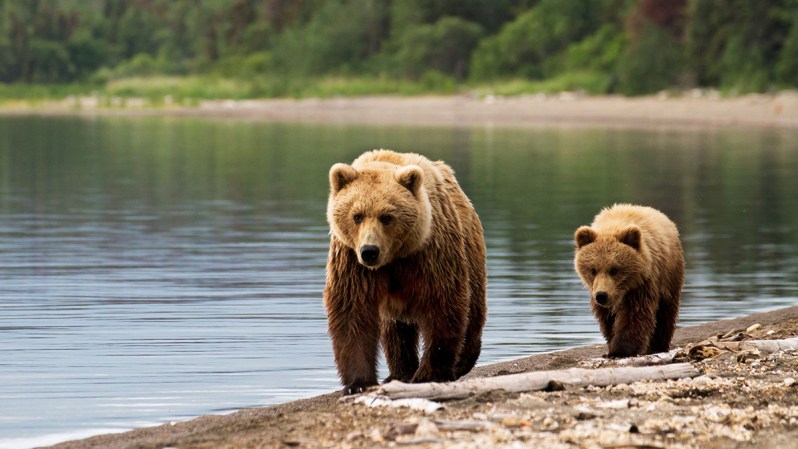
When camping cooler manufacturers want to get their new products verified bear-resistant, they call one man.
His name is Randy Gravatt and he’s been working at The Grizzly & Wolf Discovery Center (GWDC) in West Yellowstone, Montana for nearly two decades.
Gravatt and the GWDC were approached 15 years ago by the Interagency Grizzly Bear Committee (IGBC) to begin a Bear Container Testing procedure. The GWDC, being located at one of the busiest entrances to Yellowstone National Park, houses eight rescue bears and is famous for offering park visitors with information about bear country, and why it’s essential to have the right gear while visiting.
Yep, there’s an actual facility where brands like OtterBox, Yeti, and Field & Stream send their prototypes to be tossed around and shredded by a grizzly bear.
A couple brands even put out videos of their tests, as was the case with OtterBox for its Ultra Bear-Resistant Venture Coolers (which made it through the procedure). Videos like these give campers, anglers, and outdoorsmen a better sense of just how skilled bears are at getting into coolers. Or, some coolers, that is.
Although it may not seem vital to invest in an IGBC-certified cooler and trash can, these are the only products that can stand up to a bear that might wander into camp. Bears are quick to associate such containers with food, humans with food, and campsites with food. As a result, they are often killed because of the dangers these associations present — these are the bears that the GWDC rescues.
Gravatt’s work with Bear Container Testing ensures that even if a bear gets its paws on your cooler, it won’t be successful in opening it. “The ultimate goal is that it benefits the bears out in the wild,” he says. “If they don’t get the food, they keep moving on and stay in the woods.”

Gravatt tells The Manual that coolers with the IGBC certification have withstood 60 minutes of contact time with a real, hungry grizzly, and come out the victor. Gravatt’s bears test anywhere between 40 and 80 new products a year (many from China, but some domestic brands as well). The pass-rate back when testing began 15 years ago was a weak 10 percent. Today, Gravatt says it’s closer to 60 percent.
“What cooler designers didn’t realize was how strong, smart, and food-driver bears were,” Gravatt says. “And the same for park visitors who believe a bungee cord around a cooler will keep a bear out. But bears are so unbelievably smart.” In fact, Gravatt says bears have come up with their own method of opening coolers he calls “the CPR Method,” where they bounce a cooler up and down as if they’re doing CPR.
During Gravatt’s tests, he fills the prototype coolers with dried dog kibble; not only will the smell attract the bear, but the noise of the kibble jostling around adds an extra drive to get inside.

“Bears average 10,000 calories a day,” Gravatt tells The Manual. “And that number can go up to 30,000 a day between September and October while it’s building up fat reserves for hibernation.” So in essence, bears are hungrier than you when you miss lunch and dinner, and will go to extreme lengths to get food. If by chance they do get food from a non-certified cooler or trash can, it can mean possible devastation and death for both the bears and fellow campers.
Gravatt gave this example of why everyone living in or traveling through bear country needs an OGBC-certified cooler and trash can:
You have the Smiths and the Jones. The Smiths are super clean, they put their garbage away, and have a certified, bear-resistant trash can. The Jones have bags of trash in the back of their pickup, bird feeders everywhere, and don’t have a certified can. Well, Mr. Smith leaves his glasses in the car and goes out at night to get them, running into a mama bear and her two cubs who have just rummaged the trash and feeders from the Jones’. The bear attacks Mr. Smith, where he was doing everything correct.
The moral of the Gravatt’s story, as he says, is “we should all do everything we can.” Apart from the human danger element, he says some 30-40 grizzly bears get put down every year between Idaho, Montana, and Wyoming. The number of black bears is even higher.
Before you save change on a cheap-o cooker from Walmart, consider shelling out the extra few dollars on a OGBC-certified cooler from brands like Yeti and OtterBox (plus a padlock!). Then you can zip up your tent and rest easy knowing your eggs and bacon will be safe in the morning.
Just to be prepared, though, check out our tips on how to survive a bear attack.
Article originally published August 17, 2017. Last updated April 24, 2018.


